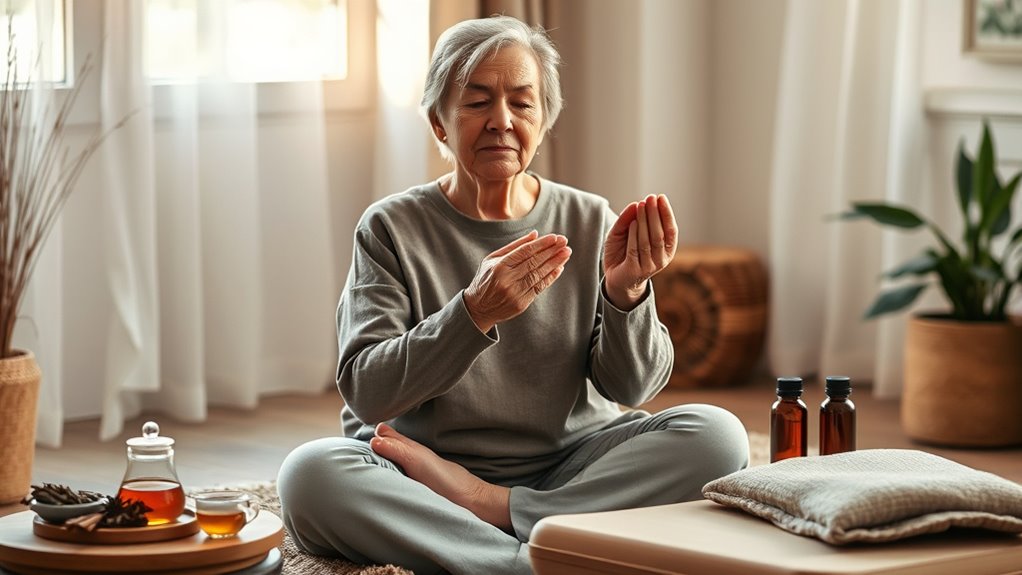To manage arthritis pain in seniors, focus on maintaining a healthy weight, staying active with gentle exercises, and choosing anti-inflammatory diets. Use medications or supplements as advised by your healthcare provider and explore therapies like acupuncture or massage to ease discomfort. Support your joint health with proper techniques and lifestyle changes, including stress reduction and consistent movement. For more strategies to improve your comfort and mobility, keep exploring effective options tailored for your needs.
Key Takeaways
- Maintain a healthy weight and engage in gentle exercises like walking or swimming to reduce joint stress.
- Use medications, supplements, and topical treatments under healthcare supervision to manage pain and inflammation.
- Incorporate stress-reducing activities and physical therapy options such as water therapy to improve mobility.
- Explore alternative therapies like acupuncture and herbal remedies to complement traditional treatments.
- Regularly monitor joint health, recognize early symptoms, and consult healthcare providers for personalized management.
Understanding Arthritis and Its Impact on Seniors

Arthritis is a common condition among seniors that causes inflammation, pain, and stiffness in the joints. It primarily results from joint inflammation, which leads to tissue damage and discomfort. Over time, cartilage deterioration occurs, reducing the protective cushioning in your joints. As cartilage wears away, bones may rub against each other, intensifying pain and limiting movement. This process often affects weight-bearing joints like hips, knees, and hands, making daily activities more challenging. Understanding how arthritis impacts your joints helps you recognize why pain and stiffness develop. Early awareness of these changes allows you to seek appropriate treatment and manage symptoms more effectively. Knowing this foundation is essential for taking proactive steps to maintain joint health and improve your quality of life. Proper management can significantly reduce pain and improve mobility. Additionally, incorporating joint-friendly practices and lifestyle modifications can help slow disease progression and support overall joint function. Recognizing the importance of muscle strength around affected joints can also contribute to better stability and reduce strain. Improving joint stability through targeted exercises may help prevent further joint damage and enhance overall function.
Recognizing Common Symptoms and Warning Signs

Being able to identify the symptoms and warning signs of arthritis can make a significant difference in managing the condition early on. You might notice persistent joint pain, swelling, or stiffness, especially after periods of inactivity. Reduced range of motion and tenderness are common signs to watch for. Pay attention to changes in your mental health, such as increased feelings of frustration or depression, which can result from ongoing discomfort. Incorporating diet modifications like anti-inflammatory foods may help alleviate symptoms, but recognizing the early signs remains essential. Additionally, understanding the horsepower of electric dirt bikes can help in differentiating between types of motorized vehicles, which is relevant when considering mobility options for seniors. If you experience joint redness, warmth, or a sudden increase in pain, seek medical advice promptly. Recognizing joint inflammation and its associated symptoms can aid in early diagnosis and treatment. Being aware of these warning signs allows you to take timely steps to manage arthritis and improve your overall well-being. For example, learning about RMDs and their rules can help in planning appropriate treatment strategies and avoiding complications.
Effective Lifestyle Changes to Reduce Pain

To reduce arthritis pain, focus on maintaining a healthy weight, which lessens stress on your joints. Incorporating gentle exercises like walking or swimming can strengthen muscles and improve flexibility. Making these small changes can make a noticeable difference in managing your symptoms. Additionally, staying informed about advancements in automation technology can help you understand new tools that may support your health management. As AI technologies become more integrated into healthcare, AI-driven diagnostics are increasingly providing accurate and early detection of joint issues. Exploring innovative textile line solutions may also offer additional support for comfort and mobility. Staying updated on portable camping gear innovations can inspire creative ways to adapt your environment for greater comfort. Being aware of paint sprayer technology can also inspire you to find easier ways to maintain your home environment comfortably.
Maintain a Healthy Weight
Maintaining a healthy weight is one of the most effective ways to reduce arthritis pain in seniors. Excess weight puts extra stress on your joints, worsening pain and inflammation. By focusing on healthy eating, you can support weight management and reduce strain on your joints. Stress reduction also plays a crucial role, as stress can increase inflammation and discomfort. To help maintain a healthy weight, consider these tips:
- Prioritize nutrient-dense foods and control portion sizes
- Incorporate stress-reducing activities into your routine
- Limit processed foods and added sugars
- Stay consistent with your healthy eating habits
- Engaging in music therapy sessions can help manage stress and promote relaxation, further supporting weight management efforts. Additionally, understanding the types of foods that promote joint health can enhance your diet plan and reduce arthritis symptoms. Recognizing how nutrition impacts inflammation can guide you toward more effective dietary choices. Maintaining hydration levels is also essential, as proper hydration supports joint lubrication and overall health. Incorporating regular physical activity tailored to your abilities can further aid in weight management and joint health.
Achieving and maintaining a healthy weight can considerably lessen arthritis symptoms and improve your overall well-being.
Incorporate Gentle Exercise
Incorporating gentle exercise into your routine can markedly reduce arthritis pain and improve joint mobility. Gentle stretching helps keep your muscles flexible and reduces stiffness, making daily movements easier. Engaging in low-impact workouts like walking, swimming, or cycling protects your joints from excessive strain while strengthening the muscles around them. Regular activity can also decrease inflammation and boost your overall energy levels. Remember to start slow, listen to your body, and avoid overexertion. Incorporating these simple exercises into your daily schedule can make a significant difference in managing pain and maintaining independence. Gentle movement not only benefits your joints but also enhances your mental health by releasing endorphins that elevate mood. Regular participation in live music venues may also provide additional mental and emotional benefits, supporting overall well-being. Additionally, staying informed about arthritis management strategies can help you make better choices for your health. Incorporating joint-friendly activities into your routine can further improve your quality of life. Including glycolic acid in skincare routines may also help improve skin texture and reduce signs of aging, contributing to overall skin health. Always consult your healthcare provider before beginning a new exercise routine to ensure it suits your specific needs and health status.
The Role of Medications and Supplements

Medications like NSAIDs and corticosteroids can help manage your arthritis pain, but they come with potential side effects you should be aware of. Supplements such as glucosamine and chondroitin may offer relief, though their effectiveness varies. It’s important to understand the benefits, risks, and precautions before incorporating any medications or supplements into your pain management plan. Additionally, exploring complementary approaches like positive affirmations and visualization techniques can support a more holistic approach to managing discomfort. Trustworthy brands in supplements and medications are essential to ensure safety and efficacy.
Common Medication Options
Have you ever wondered which medications can effectively ease arthritis pain in seniors? There are several options to contemplate. Over-the-counter pain relievers like acetaminophen and NSAIDs are common first choices. Your doctor might also recommend topical creams or patches for targeted relief. Additionally, prescription medications such as corticosteroids help reduce inflammation. Incorporating diet modifications can support overall joint health, while pain relief devices like braces or heat wraps can provide supplementary comfort. It’s important to balance medication use with lifestyle strategies. Always consult your healthcare provider before starting or changing medications, especially since some drugs may interact with other treatments. Combining medication options with smart lifestyle choices can considerably improve your quality of life.
Benefits of Supplements
Supplements can play a valuable role in managing arthritis pain for seniors, often complementing traditional medications. They may support joint health, reduce inflammation, and improve mobility. When selected carefully, supplements can boost your overall well-being and comfort. However, it’s crucial to prioritize supplement safety and consult your healthcare provider before starting any new regimen. Knowing which supplements are effective and safe helps you make informed decisions. Remember, not all supplements are created equal, and quality matters. Here’s a look at some common supplements and their emotional benefits:
| Supplement | Benefits | Key Considerations |
|---|---|---|
| Glucosamine | Supports joint repair | Ensure purity and dosage |
| Chondroitin | Reduces inflammation | Talk to your doctor |
| Omega-3 Oils | Eases stiffness, improves mood | Check for purity |
| Turmeric | Natural anti-inflammatory | Confirm safety for you |
| Vitamin D | Boosts bone and joint health | Monitor levels regularly |
Risks and Precautions
While supplements can offer helpful support for managing arthritis pain, they also carry potential risks, especially if not used correctly. Some medications and supplements may cause side effects, like gastrointestinal issues or allergic reactions. It’s vital to consult your healthcare provider before starting new treatments to avoid adverse interactions. Overuse or misuse of medications can lead to complications, so always follow dosage instructions. Additionally, incorporating joint protection techniques can reduce reliance on medications and minimize side effects. Be cautious and stay informed about the potential risks involved. Regular check-ins with your doctor help monitor medication effects and adjust treatments as needed. Prioritizing safe practices ensures effective pain management while reducing the likelihood of complications.
Physical Therapy and Exercise Options

Physical therapy and exercise can play a crucial role in managing arthritis pain for seniors. Engaging in tailored activities helps strengthen muscles, improve flexibility, and reduce joint stress. Water therapy is especially gentle; floating in warm water eases pain and allows you to perform resistance training safely. Resistance exercises strengthen muscles around affected joints, providing better support and stability.
| Activity Type | Benefits | Ideal For |
|---|---|---|
| Water therapy | Reduces joint strain, eases pain | Seniors with severe joint issues |
| Resistance training | Builds muscle, stabilizes joints | Those seeking increased strength |
| Range-of-motion exercises | Maintains flexibility | All seniors with arthritis |
| Low-impact aerobics | Boosts cardiovascular health | Overall well-being |
| Stretching | Improves flexibility, reduces stiffness | Daily routine |
Incorporate these options gradually for better arthritis management.
Alternative and Complementary Therapies

Many seniors find that alternative and complementary therapies can provide additional relief from arthritis pain. These approaches often work alongside conventional treatments to improve comfort and mobility. Acupuncture therapy, for example, involves inserting fine needles into specific points to reduce pain and inflammation. Herbal remedies, such as turmeric or ginger, may also help ease joint discomfort naturally. While these therapies can be beneficial, it’s essential to consult your healthcare provider before trying them to ensure safety and effectiveness. Keep in mind that individual responses vary, and some methods may work better for you than others.
Complementary therapies like acupuncture and herbal remedies may ease arthritis pain safely.
- Acupuncture therapy for pain relief
- Herbal remedies like turmeric and ginger
- Massage therapy for muscle relaxation
- Mind-body practices such as meditation
Tips for Daily Management and Comfort

Incorporating alternative therapies like acupuncture or herbal remedies can help reduce arthritis pain, but daily habits and routines are essential for ongoing comfort. To improve joint flexibility, stay active with gentle exercises like swimming or walking, which keep your joints mobile without causing strain. Recognize and avoid pain triggers such as repetitive movements or cold weather, which can worsen discomfort. Maintain a healthy weight to reduce stress on your joints and incorporate anti-inflammatory foods into your diet. Use assistive devices when needed to lessen joint strain during daily tasks. Prioritize rest and good posture to prevent stiffness. By establishing consistent routines, you can better manage pain triggers and support your joints’ health, helping you stay comfortable and active each day.
Frequently Asked Questions
Are There Specific Foods That Can Worsen Arthritis Pain in Seniors?
Certain foods can worsen your arthritis pain by acting as diet triggers or revealing food sensitivities. You should watch out for processed foods, sugar, and greasy dishes, as they can promote inflammation. Dairy and gluten might also cause issues if you’re sensitive. Identifying and avoiding these triggers helps reduce pain. Pay attention to how your body reacts after eating, and consider talking to a healthcare professional for personalized advice.
How Can Caregivers Best Support Seniors With Arthritis at Home?
Think of yourself as a guiding star, helping seniors navigate daily routines with ease. To support them at home, you can introduce assistive devices like grab bars or ergonomic tools to make tasks easier. Encourage gentle exercises and set up a comfortable environment. Your patience and proactive approach help ease their pain, making daily life smoother and more manageable—proving that small acts make a big difference.
What Are the Latest Advancements in Arthritis Pain Management for Seniors?
You should know that recent advancements include new medications and innovative therapies that target arthritis pain more effectively. These options can reduce inflammation and improve mobility with fewer side effects. Staying updated with these developments allows you to explore personalized treatment plans. Consult healthcare professionals about the latest treatments, ensuring your loved ones benefit from cutting-edge solutions that enhance their quality of life and manage pain more efficiently.
Can Arthritis Pain Lead to Other Health Complications in Seniors?
Imagine a senior with untreated arthritis, and it leads to decreased mobility. This can cause muscle weakness and balance issues, increasing health risks like falls. Arthritis complications often extend beyond joint pain, raising the risk of cardiovascular problems and depression. You should be aware that unmanaged arthritis can directly contribute to other health issues, making it essential to address symptoms early to prevent further health risks and complications.
How Does Mental Health Impact Arthritis Pain in Older Adults?
Your mental health considerably influences how you perceive pain, including arthritis discomfort. When you’re feeling anxious or depressed, your pain perception can intensify, making arthritis feel worse. Conversely, maintaining good mental health can help you manage pain better by reducing stress and improving your overall resilience. Staying positive and seeking support can make a real difference in how you experience and cope with arthritis symptoms daily.
Conclusion
Managing arthritis pain as a senior can feel overwhelming, but with the right strategies, you’re in control. Implementing lifestyle changes, exploring therapies, and staying active make a difference. Yet, the journey doesn’t end here—there are still secrets to uncover that could transform your comfort even more. Are you ready to take the next step toward a pain-free life? Keep exploring, because your best days of relief might just be around the corner.






